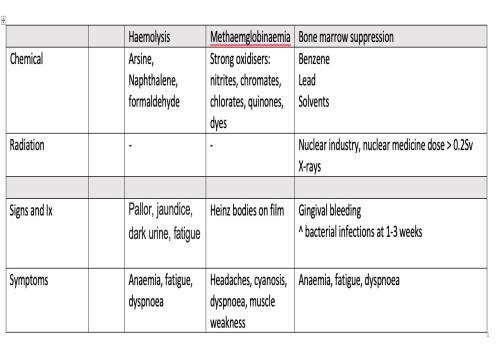Blood disorders

Occupational Health Considerations
Occupational blood disorders are broadly divided into immediate and very long term (malignancies). The shorter term pathologies are bone marrow suppression leading to a delayed (1-3 weeks) circulatory pancytopenia and symptoms of anaemia and increased infection risk, haemolysis (premature destruction of red blood cells) possibly leading to anaemia, methaemoglobinaemia and increased reticulocyte count, in the presence of occupational strong oxidising occupational agents. These are summarised in the table above.
Clinical Aspects
Notes
Lead: battery manufacture / recycling , smelting, demolition , glass making. Lead can induce nerve palsies and erythrocyte basophilic stippling on blood film.
Arsine: produced chemical processes where arsenic is an impurity: metal processes and soldering
Napthalene: 'mothballs', plastics and dye manufacture
Benzene: an impurity in many oil feedstocks, plastics manufacture, explosives, petroleum / gasoline. Exposure above 40 ppm. Very long chronic exposure can cause acute myeloid leukaemia.
Radiation: dose > 4000-6000 mSv has fatality rate of 50% within one month mainly due to bone marrow suppression and overwhelming multi organ failure. Doses of 200 mSV start to produce immediate (1-3 weeks) effects on the marrow. The exposure level of a citizen not exposed to industrial sources of radiation is below 1 mSv annually . Radiation workers may be exposed to <20 mSv annually. Chronic exposure to ionising radiation can cause multiple myeloma or non-Hodgkins lymphoma.
My reflection

